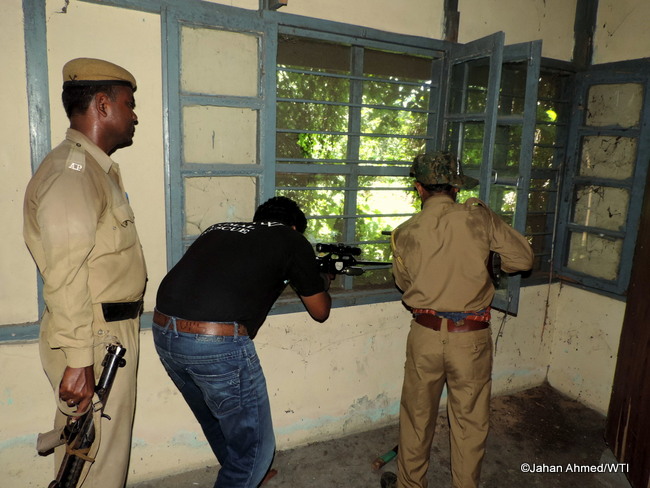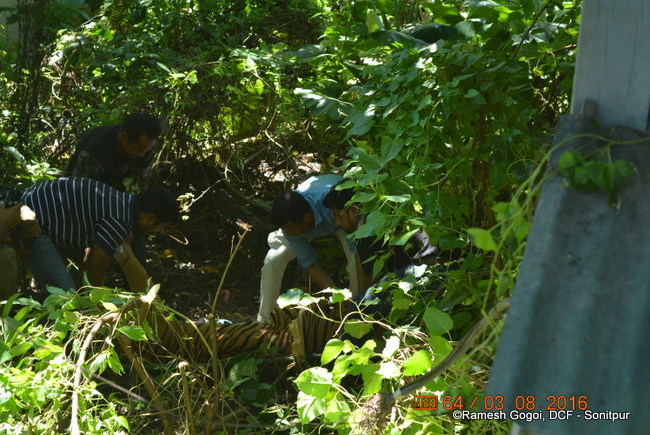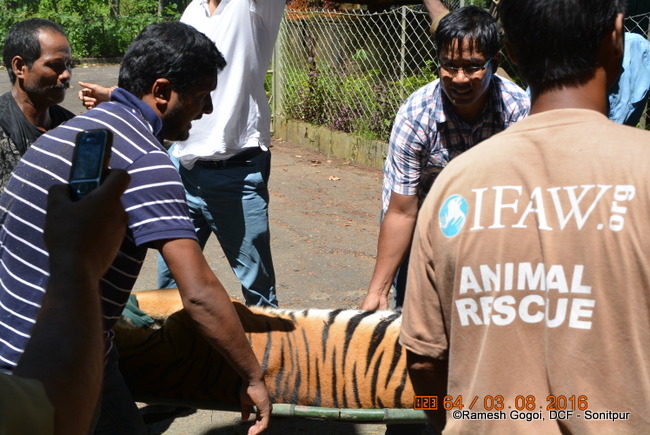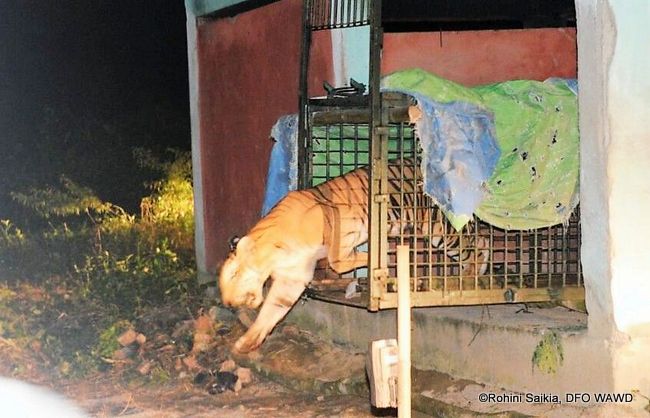First-hand Account: MVS Team Rescues, Releases Tezpur Conflict Tigress
Mr Siva Kumar called Dr Rathin Barman, centre-in-charge at CWRC at about 8.00am the next morning – this was now a conflict situation requiring our direct intervention, as the tigress had attacked and seriously injured a boy earlier that morning.
 Dr Samshul Ali prepares to dart the tigress through the window of an abandoned structure at the NERIWALM campus, Tezpur
Dr Samshul Ali prepares to dart the tigress through the window of an abandoned structure at the NERIWALM campus, Tezpur
We decided to wait till nightfall, ask people to stay indoors and drive the tigress away in a coordinated manner towards Bhomoraguri.
SA: In consultation with the CF Mr Siva Kumar, we decided that we would not disturb the animal during the day when more people were out and about; we would instead wait till nightfall, ask people to stay indoors and drive the tigress away in a coordinated manner towards Bhomoraguri about a kilometre away. Tranquilising the animal would be a last resort. (This consensus having been reached, Dr Choudhury left the team to resume his work at Manas National Park.)
Shortly thereafter, we heard a loud roar and the tigress revealed her presence: three unruly youths had snuck past the civil administration’s barricade and entered the thicket. Fortunately they were able to flee for their lives and the tigress retreated into the undergrowth.
At 9.30pm the drive began. Frontline forest staff burst crackers and a forest guard atop an elephant (Joonmala) approached the area where the tigress had been seen. Suddenly a loud trumpeting was heard, then a splash in a pond near the thicket, then a roar beneath the balcony where Mr Sivakumar and I were stationed with forest guards, bursting crackers to drive the tigress away from the campus. But as sometimes happens with the best laid plans, this one didn’t work – the tigress made her way back into the campus! Mr Saikia, the DFO WAWD, quickly told campus security to direct everyone to stay indoors.
JA: On the morning of August 3, we ventured out on Joonmala’s back towards the area in NERIWALM where the tigress had first been spotted. CWRC animal keeper Hemanta Das directed our attention to a tree where monkeys were making a lot of noise. We got off to ready our darts if required, sending Forest Guard Vishnu with the mahout to investigate. Vishnu confirmed that the tigress was lying in front of an abandoned structure (the Arunachal-2 Quarter) in an area covered with thick bushes.
The tigress had barely reacted to either dart. They were both brand new; what was up? Now she stood up and started walking. Her gait was unsteady.
Samshul and I prepared the tranquiliser darts and approached the tigress on elephant back. We could see the animal but there was no clear shot through the undergrowth. Samshul suggested that we approach from the other side, through the dilapidated structure, leaving the elephant where it was to distract the tigress. I broke the quarter’s lock and with Samshul and Vishnu moved towards the tigress. We now had a better view of her through the mesh of a window, lying about 15 feet from the room we were in. Making a small hole in the window’s wire mesh, Samshul stuck the tranquiliser rifle through and darted the animal. It was 11.34am. The dart hit the tigress on the right side of its neck. A perfect shot. We waited for a while but the anaesthetic did not seem to have had any effect, so Samshul fired another dart at 11.49am.
SA: The tigress had barely reacted to either dart. They were both brand new; what was up? Now she stood up and started walking. Her gait was unsteady. I desperately wanted a view of the darts but she moved to another abandoned building out of our line of sight.
The tigress was calm and we could see her entire body, which helped us to estimate her body weight. I calculated the required dose; we could use one dart and fire a top-up. This time I darted her on her rump and the dart delivered the full dose. About 10 minutes later the tigress’s head was dropping, but a top-up was necessary; Jahan darted her using the pneumatic pistol. Seven minutes later, at around 12.45pm, the tigress was fully sedated.
We placed the animal on a folding stretcher and transferred her into a trap cage. She had a superficial wound on the right belly and the inguinal region. We used a topical antiseptic ointment and antibiotic spray to treat the wounds.
JA: The Principal Chief Conservator of Forests, Assam, and the National Tiger Conservation Authority’s Mr DP Bankhwal (Inspector General of Forests) and Mr Kamal Azad determined that the animal should be released in Nameri National Park. The site for release was to be Bogijuli Forest Camp, which could be approached through Seijosa.
The tigress was placed in a small truck and we started at 5pm. Water was sprayed on her to keep her cool. We moved at a careful pace, reaching Seijosa at 7.30pm, halting for a bit and moving on to Bogijuli.
The tigress had some self-inflicted external injuries on her forehead but was otherwise in good shape. The cage was unloaded into the hollow foundation of the camp. We set up four camera traps in strategic positions and attached a hook by which the cage door could be pulled up with a rope. After ensuring that everyone was either in the camp or in their vehicles, I fixed the hook to the door and climbed up to the camp. Samshul and accompanying personnel* pulled the rope: the door moved up and the tigress exited the cage at once. She looked around cautiously, then slowly moved into the forest.
*Staff of the Sonitpur West Division, Western Assam Wildlife Division, Nagoan Forest Division, and Civil Administration Sonitpur were present at the tigress’s release, as was the Circle Officer, Seijosa. IFAW-WTI wishes to acknowledge the invaluable support provided to the MVS team at NERIWALM by Mr Rohini Saikia, DFO WAWD, Mr Siva Kumar, CF North Assam Circle, Mr Vishnu, Forest Guard, and Mr Saurav Borkotoky, photojournalist.












